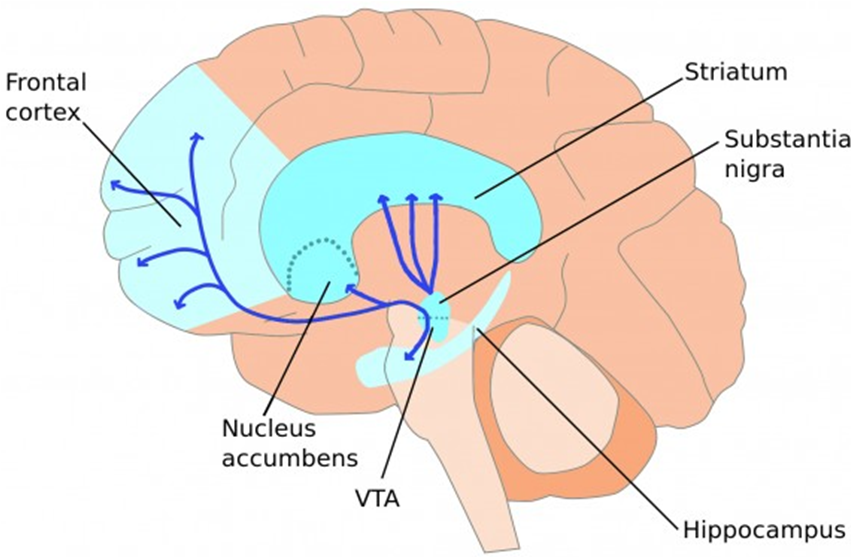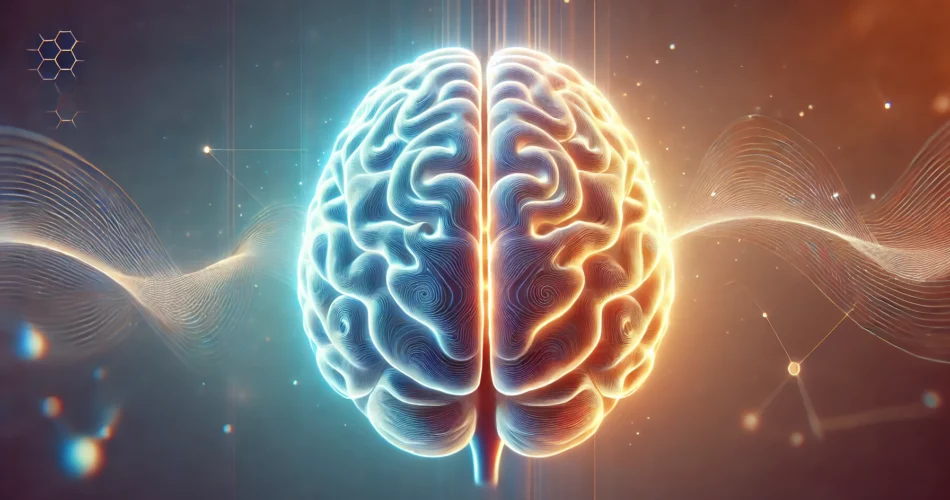Dopamine. You’ve probably heard it mentioned as the “feel-good chemical” or “pleasure molecule.” But dopamine is much more than that – and understanding how it works is essential if you’re trying to grasp your life and find lasting joy, not just temporary highs.
What Is Dopamine?
Dopamine is a neurotransmitter – a chemical messenger in your brain. It plays a central role in motivation, reward, learning, and habit formation. Harvard Health describes it as a pathway to pleasure.
Despite what many people think, dopamine isn’t about pleasure itself. It’s about wanting. Craving. Anticipation. It’s the chemical that says: “That thing? Go get it.” Whether it’s a slice of pizza, a promotion, or the next episode on Netflix – dopamine is what creates that drive to act.
How Dopamine Works in the Brain
To understand dopamine, you need to think of it not as a reward – but as a signal that something might be rewarding. It’s not about pleasure itself, but the anticipation of it. This is what drives us to take action, repeat behaviors, and form habits.
Here’s how the process typically works:
- A trigger appears – This could be anything: the smell of coffee, a phone notification, a flirty text, a new goal you set.
- The brain evaluates it – Your brain asks: Is this worth pursuing? Is this something that could bring a reward?
- If yes, dopamine is released – Dopamine-producing neurons (mostly in the Ventral Tegmental Area, or VTA) fire, releasing dopamine into other brain regions like:
- Nucleus Accumbens – which assigns importance and “wanting” to the trigger
- Frontal Cortex – which helps you plan and decide how to get it
- Striatum – which starts forming the habit loop (cue > action > reward)
- You feel motivated to act – Dopamine makes you feel energized and focused on getting the reward. It doesn’t make you happy – it makes you pursue what you think will make you happy.
- The outcome happens – You either get the reward (good meal, praise, hit of sugar, achievement) or you don’t.
- The brain learns – If the reward was better than expected, dopamine spikes even more next time. If it was disappointing, dopamine drops. This is how your brain updates what’s worth chasing and what’s not.
This process is constantly running in the background – hundreds of times a day. From checking your phone to starting a business, it’s all powered by dopamine-driven loops.

Dopamine and Evolution: Why We Have This System
Our dopamine system evolved for survival. Thousands of years ago, it motivated humans to do things like:
- Hunt for food
- Find shelter
- Reproduce
- Form social bonds
- Explore new environments
These actions were critical for staying alive. Dopamine acted as a reward prediction system – it helped us remember what worked, what felt good, and what was worth repeating.
It was never about constant pleasure. It was about reinforcing useful behavior and keeping us moving forward. In an environment where rewards were rare and difficult to obtain, this system was incredibly effective.
Dopamine in Today’s World
Here’s the problem: we no longer live in that environment.
Today, we are surrounded by artificial, easy, high-dopamine triggers:
- Social media (likes, comments, novelty)
- Processed food (sugar, fat, salt)
- Video games
- Pornography
- Online shopping
- 24/7 news and entertainment
- Gambling
- Endless scrolling
These things give us rapid dopamine spikes with almost zero effort. And our brains – still wired for survival in a much harsher world – can’t tell the difference between a meaningful reward and a superficial one. Dr. Andrew Huberman breaks this down brilliantly in his lecture on how dopamine affects motivation and behavior.
Over time, this leads to:
- Desensitization: The brain adapts and needs more stimulation for the same effect
- Cravings: We keep chasing the next hit
- Numbness: Natural pleasures feel dull in comparison
- Burnout: Constant overactivation leads to emotional and physical exhaustion. I’ve written more about my personal experience with burnout here
This is why so many people feel unmotivated, overstimulated, and disconnected from what used to bring them joy.
The Dopamine Pool: Why Too Many Hits Leave You Empty
Here’s a helpful metaphor:
Your dopamine system is like a swimming pool.
- The water level = your baseline dopamine
- The prediction of a rewarding experience = a splash into the pool
- The bigger the splash above the water, the more exciting it feels to your brain
This difference between where you are (baseline) and where the reward takes you = the contrast, or the “dopamine spike.”
But here’s the problem:
If you’re constantly throwing rocks into the pool – doomscrolling, gaming, snacking, binge-watching – the waves start spilling water out. Over time, the pool drains.
That’s what happens when your baseline dopamine drops.
What Happens When You Don’t Follow the Urge?
Now that we understand how dopamine drives action, here’s something interesting:
You don’t always act on dopamine. And that’s important.
Let’s say a thought pops into your head:
“Let’s order pizza.”
Your brain immediately starts predicting the reward: crispy crust, melted cheese, satisfaction.
This prediction triggers a dopamine response – even before you’ve done anything. It starts to fill the pool with anticipation.
But then another part of your brain kicks in:
“Wait… we’re trying to eat healthier.”
That voice comes from your prefrontal cortex – the part of your brain responsible for long-term goals, reasoning, and self-control. It can override the dopamine-driven urge.
So what happens?
- You feel the pull (dopamine signal = splash)
- But you don’t act (your prefrontal cortex says no)
- No reward is delivered
- Your brain notes the outcome: “Okay, sometimes this craving doesn’t lead to payoff.”
And over time? That particular habit loop can weaken.
This is how new habits form – not by eliminating dopamine, but by learning to respond to it differently.
💡 It’s like seeing a big splash in the dopamine pool… and deciding not to jump in.
You’re not draining the pool – you’re simply watching the waves settle. And the more you do that, the easier it becomes.
Why Baseline Dopamine Is the Key to Motivation
Here’s where it all comes together.
Your brain’s dopamine system relies on two things:
- Your baseline level – your default dopamine state
- The predicted reward – the spike your brain expects
If the predicted spike is meaningfully above the baseline, your brain says:
“Let’s go for it!”
But if your baseline is too low, the entire system becomes unresponsive.
Even if a reward should feel exciting, your brain:
- Doesn’t have the energy to care
- Can’t detect the difference
- Fails to release enough dopamine
- Doesn’t push you to act
💡 Another way to think of it:
Your baseline dopamine is like fuel in a car. Even if the destination (reward) sounds amazing, if your tank is empty, you can’t get there. That’s what happens in burnout – you want to feel motivated, but your system is running on fumes.
This is why people say:
- “I want to work, but I just can’t start”
- “Even things I used to love feel dull”
- “Everything feels like too much effort”
It’s not mental weakness. It’s a neurochemical imbalance.
When the Baseline Is Too High
Ironically, having a constantly high baseline also kills motivation.
When you’re flooded with dopamine all day, normal rewards (like walking, creating, or finishing tasks) don’t rise above the noise.
Your brain says:
“That’s not exciting enough.”
This is dopamine tolerance. You need bigger and faster hits to feel something – and everything else becomes boring.
Dopamine Isn’t Bad – But It Needs Balance
Let’s be clear: dopamine isn’t the enemy.
It’s a vital part of how we grow, connect, focus, and pursue what matters. Without it, there’s no motivation to do anything – not even get out of bed.
The problem isn’t dopamine itself. It’s the constant artificial overstimulation of it. When the system is overloaded, it becomes harder to enjoy real life.
But the good news? You can reset. You can build a healthier relationship with dopamine – one that actually supports your goals, not sabotages them.
Here’s how to start:
1. Avoid dopamine loop traps
Start noticing when you’re stuck in a loop – mindless scrolling, binge-watching, snacking. These give short-term hits but leave you emptier afterward.
2. Embrace delayed gratification
Working toward long-term goals (fitness, deep work, meaningful projects) activates dopamine more sustainably – and makes the payoff feel real.
3. Take intentional breaks
Try mini “dopamine detoxes.” Even one phone-free afternoon, a day offline, or a walk without music helps your system reset.
4. Reconnect with low-dopamine joy
Walking, journaling, reading, conversations, stillness – these don’t flood your brain, but they gently refill the pool.
5. Focus on intrinsic rewards
Don’t just chase what feels good. Do things that mean something to you. That’s where sustainable motivation lives.
Balance is the goal – not boredom.
The aim isn’t to eliminate dopamine, but to use it consciously, so you can enjoy both the process and the payoff.
Final Thoughts
Your brain isn’t broken. It’s just overwhelmed.
Your motivation isn’t gone – it’s buried under a dopamine system that’s been overstimulated, numbed, and drained.
But the moment you stop chasing artificial highs, your baseline begins to rise. Your sensitivity returns. And suddenly, real life starts to feel good again.
You don’t need more dopamine.
You need balance.
And a brain that finally feels – naturally, and fully – alive.
